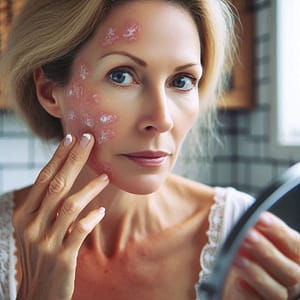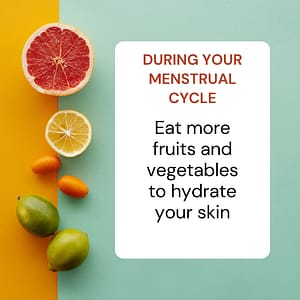Understanding Skin Changes
Understanding the cyclical nature of skin changes during menstruation can feel like deciphering a secret code, especially when navigating the hormonal rollercoaster that drives these shifts. As a woman over 40, you might observe that your skin reacts differently than it used to, largely due to the fluctuating hormone levels throughout your menstrual cycle. Let’s explore how these hormonal shifts affect your skin and what you can anticipate during each cycle phase (American Academy of Dermatology, 2023).
Hormonal Influence on Skin
Your skin reflects the complex symphony of hormones that ebb and flow throughout your menstrual cycle. Estrogen, known for its role in keeping your skin smooth and firm, experiences highs and lows that affect your skin’s texture, thickness, and even its ability to retain moisture. During the times when estrogen levels dip, you may notice your skin losing some of its luster and resilience (Flo Health).
On the flip side, progesterone, which surges in the mid-cycle, prompts your skin to produce more sebum, a natural lubricant that, in excess, can lead to clogged pores and acne. This hormonal increase causes the skin to swell and the pores to close, trapping sebum and setting the stage for breakouts (WebMD). It’s a perfect storm when testosterone levels remain constant throughout the cycle, further stimulating the sebaceous glands and exacerbating skin woes as your period approaches.
Understanding these hormonal influences is key to managing hormonal skin changes effectively and maintaining a radiant complexion even as you navigate through different life stages, such as menopause and perimenopause.
Impact of Menstrual Cycle
Your menstrual cycle can feel like a monthly test of your skin’s resilience. During the premenstrual phase, about 10 days before your period starts, many women experience what’s known as menstrual acne. This flare-up is not just common; it’s expected, with 63% of acne-prone women reporting premenstrual breakouts (Clue).
The reason behind these breakouts? It’s largely due to hormonal fluctuations. Estrogen and progesterone levels drop as your period nears, while testosterone stays steady, relatively increasing its presence. This hormonal imbalance can lead to an increase in sebum production, resulting in those all-too-familiar blemishes.
Navigating through these cycles requires a keen understanding of your body’s rhythms. By recognizing the signs and adjusting your skincare routine accordingly, you can mitigate some of the less desirable effects, such as breakouts and changes in skin texture. It’s also beneficial to explore lifestyle factors that can influence your skin’s health, including stress, nutrition, and hydration. With the right knowledge and tools, you can maintain healthy, glowing skin throughout your menstrual cycle and beyond.
Common Skin Issues
During your menstrual cycle, you may notice some changes in your skin, including acne breakouts and eczema flare-ups. These issues are fairly common and often linked to the hormonal shifts your body goes through during this time.
Acne Breakouts
Acne breakouts are a significant concern that many women encounter, particularly in the days leading up to and during their menstrual period. Approximately 65 percent of people report a worsening of their acne during this time, often observing that their skin starts to clear up once their period ends (Healthline).
| Phase of Cycle | Likelihood of Acne |
|---|---|
| Week leading up to period | High |
| During period | High |
| After the period ends | Low |
The underlying cause of these breakouts is hormonal fluctuations. Before your period, hormones may trigger your sebaceous glands to release more sebum, which can clog pores and create breakouts. These hormonal shifts can also elevate skin inflammation and the proliferation of acne-causing bacteria. Additionally, testosterone, which is present in all bodies, may increase the sensitivity of sebaceous glands, leading to further sebum production and clogged pores, especially towards the end of your cycle (Healthline).
To manage acne breakouts during your cycle, consider adopting a skincare routine tailored to your skin’s needs during these phases. Also, focus on skin changes and nutrition, as a balanced diet can support your skin’s health. For more detailed guidance, refer to our section on hormonal skin changes.
Eczema Flare-Ups
Eczema, characterized by dry, itchy, and inflamed skin, can also flare up during the menstrual cycle. These flare-ups may coincide with hormonal changes, similar to those that cause acne. While the relationship between menstrual cycles and eczema isn’t as widely studied as acne and the skin, many women report experiencing more severe eczema symptoms in connection with their periods.
| Phase of Cycle | Likelihood of Eczema Flare-Up |
|---|---|
| Premenstrual | Variable |
| Menstrual | Variable |
| Postmenstrual | Variable |
If you’re dealing with eczema flare-ups during your cycle, maintaining a consistent skincare routine that includes ample hydration and gentle, fragrance-free products may help. Additionally, managing stress, which can exacerbate eczema, is essential. Explore our article on skin changes and stress for tips on how to keep your stress levels in check and potentially reduce the frequency of flare-ups.
Understanding your skin’s patterns and how they correlate with your menstrual cycle can help you better prepare and care for your skin during this time. Remember, if you’re concerned about persistent skin issues, it’s always best to consult with a dermatologist for personalized advice and treatment options.
Managing Skin Changes
As you navigate through different phases of your menstrual cycle, adapting your skincare routine and diet can help you maintain healthy, radiant skin. With a few targeted adjustments, you can address the skin changes during menstruation that many women experience.
Skincare Routine Tips
Your skin’s needs can vary significantly throughout your menstrual cycle. Here’s how you can tailor your skincare routine to these changes:
- Menstrual Phase (Days 1 to 6): You may notice your skin feeling drier and more sensitive. Fine lines and wrinkles might also appear more pronounced. Opt for gentle cleansers and hydrating moisturizers containing ingredients like hyaluronic acid to soothe and moisturize your skin. (Cutis Medical Laser Clinics)
- Follicular Phase (Days 7 to 11): As estrogen levels rise, your skin benefits from increased production of collagen, elastin, and hyaluronic acid, making it appear plumper and more youthful. This is a great time to incorporate exfoliation and vitamin C serums into your routine to enhance skin renewal and brightness.
- Ovulation Phase (Days 12 to 16): With estrogen at its peak, you may enjoy a radiant complexion. However, this can also lead to oilier skin and potential breakouts. Maintain a regular cleansing routine and steer clear of heavy skincare products to prevent clogged pores.
- Luteal Phase (Days 17 to 28): Increased progesterone can make your sebum glands more active, raising the chance of premenstrual acne. To manage this, use salicylic acid cleansers and clay masks to keep your skin clear and reduce excess oil.
Dietary Considerations
What you eat can also impact your skin’s appearance, especially during the luteal phase. Here are some dietary tips to support your skin:
- Hydration: Drink plenty of water to help reduce bloating and swelling due to water retention. Adequate hydration is crucial for maintaining supple skin. Learn more about skin changes and hydration.
- Vegetables and Fiber: Incorporate a variety of vegetables and fiber-rich foods into your diet. These nutrients support digestion, which can be beneficial for your skin’s health.
By understanding the cyclical nature of your skin and making informed choices about your skincare and diet, you can help mitigate the effects of hormonal fluctuations. Whether it’s through tailored skincare products or nutrient-rich foods, taking these steps will assist in keeping your skin looking and feeling its best throughout your cycle. For more detailed guidance on skin changes at various life stages, explore our resources on skin changes during perimenopause, skin changes during menopause, and skin changes after childbirth.
Hormonal Treatments
When you experience skin changes during menstruation, menopause, or other stages of life, hormonal treatments can be a viable option to help manage and alleviate these shifts. Understanding the available options will empower you to make informed decisions for your overall skin health.
Birth Control Options
For those encountering skin issues like acne that correlate with their menstrual cycle, birth control pills might be beneficial. These oral contraceptives can potentially reduce the impact of testosterone by raising estrogen levels. Birth control increases sex hormone-binding globulin (SHBG) to lower free testosterone, preventing acne. Certain birth control pills, such as Ortho Tri-Cyclen, Estrosten, and Yaz, have received specific approval for acne management due to their effectiveness in this role. Before considering this option, it’s important to consult with your healthcare provider to discuss the potential benefits and risks, especially if you are over 40 years old. (WebMD)
| Birth Control Pill | FDA Approval for Acne | SHBG Increase |
|---|---|---|
| Ortho Tri-Cyclen | Yes | Moderate |
| Estrosten | Yes | High |
| Yaz | Yes | High |
Hormonal Balancing Solutions
In cases where acne is directly tied to your menstrual cycle, hormonal intervention might be necessary. Professionals such as an ob-gyn or endocrinologist can offer assistance. Treatments beyond birth control pills include spironolactone, a medication that reduces oil production in the skin by targeting testosterone. In addition, for heavier individuals, shedding the extra pounds might contribute to controlling acne flares that coincide with their period. It is crucial to seek out medical advice to find the most suitable and safe hormonal balancing solution for your unique situation. (WebMD)
Hormonal treatments can be a powerful tool in managing hormonal skin changes, especially when combined with a comprehensive skincare regimen, proper nutrition, and adequate hydration. As you navigate changes in your skin, whether during puberty, pregnancy, perimenopause, after childbirth, or due to stress, it’s essential to consider all available options and consult with healthcare professionals to maintain radiant, healthy skin.

